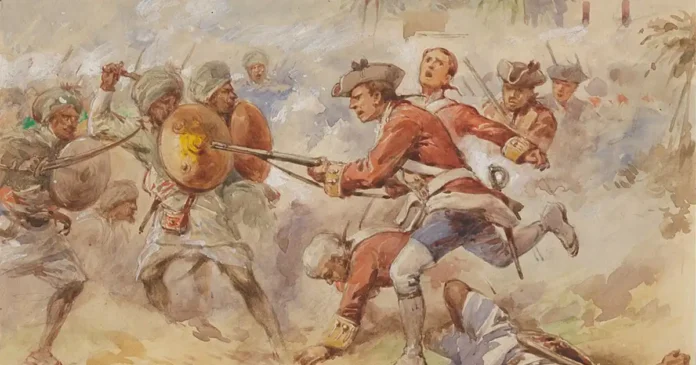The Battle of Plassey, also known as the Battle of Palashi, took place on June 23, 1757, in present-day West Bengal, India. It was a significant conflict during the period of British colonization in India and had far-reaching consequences for British control over the region.
The battle was fought between the forces of the British East India Company, led by Robert Clive, and the Nawab of Bengal, Siraj ud-Daulah. The British East India Company had established a strong presence in Bengal and had gained significant economic and political influence in the region.
Siraj ud-Daulah, the young Nawab of Bengal, was unhappy with the growing power of the British and their encroachment on his authority. He seized the British factory at Kasimbazar and captured several British prisoners, which further heightened tensions between the two sides.
Robert Clive, who was stationed at the British stronghold of Calcutta, received support from local Indian rulers who were dissatisfied with Siraj ud-Daulah’s rule. Clive formed an alliance with Mir Jafar, the commander of the Nawab’s army, who secretly agreed to support the British in the battle.
On the day of the battle, Siraj ud-Daulah’s army of around 50,000 soldiers faced a smaller British force of approximately 3,000 European troops and 2,000 Indian sepoys. However, the British had the advantage of superior artillery and military tactics.
During the battle, Mir Jafar’s forces betrayed Siraj ud-Daulah and did not actively participate in the fighting. The British unleashed a devastating artillery barrage, causing panic and confusion among the Nawab’s troops. As a result, the Nawab’s forces suffered heavy casualties, and Siraj ud-Daulah was eventually forced to flee from the battlefield.
The Battle of Plassey was a decisive victory for the British East India Company. It marked the beginning of British dominance in India and the subsequent establishment of British colonial rule. After the battle, Mir Jafar was installed as the puppet Nawab of Bengal, allowing the British to exert their control over the region more effectively.
The battle’s significance extends beyond its immediate outcome. It demonstrated the effectiveness of British military tactics against larger Indian armies and established the British East India Company as a major power in India. It also paved the way for further British expansion and control over vast territories in the Indian subcontinent in the years that followed.
Here are some key facts about the Battle of Plassey:
Key facts about the Battle of Plassey
1. Date and Location
The Battle of Plassey took place on June 23, 1757, near the village of Plassey (Palashi) in Bengal, India.
2. Opposing Forces
The British East India Company, led by Robert Clive, faced the army of the Nawab of Bengal, Siraj ud-Daulah. The British had around 3,000 European troops and 2,000 Indian sepoys, while the Nawab’s forces numbered around 50,000 soldiers.
3. Betrayal by Mir Jafar
Mir Jafar, the commander of the Nawab’s army, secretly allied with the British and betrayed Siraj ud-Daulah during the battle. His forces did not actively participate, which significantly weakened the Nawab’s army.
4. British Artillery Advantage
The British had superior artillery, including field guns and cannons, which they effectively used during the battle. Their artillery barrage caused chaos and panic among the Nawab’s troops.
5. Outcome
The British East India Company emerged victorious in the Battle of Plassey. Siraj ud-Daulah’s forces suffered heavy casualties and he was forced to retreat from the battlefield.
6. Consequences
The British victory at Plassey marked the beginning of British dominance in India. It led to the establishment of British colonial rule and paved the way for further British expansion in the subcontinent.
7. Puppet Nawab
After the battle, Mir Jafar was installed as the Nawab of Bengal under British influence. However, he served as a puppet ruler, allowing the British to exert control over the region.
8. Economic Impact
The British East India Company gained significant economic benefits from its victory at Plassey. They obtained trade concessions and became the dominant power in Bengal’s lucrative trade, particularly in textiles.
9. Political Significance
The Battle of Plassey demonstrated the effectiveness of British military tactics against larger Indian armies. It also marked a turning point in British ambitions in India, leading to further conquests and the eventual establishment of British India.
10. Controversies
The circumstances leading to Mir Jafar’s betrayal and the subsequent outcome of the battle have been subjects of debate and controversy. Some argue that Clive and the British manipulated the situation to secure their victory.
These facts provide a snapshot of the Battle of Plassey and its significance in the history of British colonization in India.
You may also like:
Conclusion
In conclusion, the Battle of Plassey was a transformative event in Indian history. It marked the beginning of British colonial rule, which would have profound and lasting effects on the social, economic, and political fabric of the subcontinent. It serves as a reminder of the complexities of imperialism, the power of alliances, and the enduring legacy of conquest and colonization.


